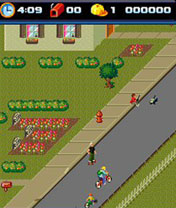
It's difficult to review a game without taking nostalgia into account. Because if you've got the nostalgia, then it's impossible to know how you'd feel about a game if you didn't have it. It's like trying to subjectively score the cuteness of your newborn baby.
So I should probably say now, I feel pretty nostalgic about Paperboy. It's right up there with all the other fond memories I have of childhood, like Back To Skool on the ZX Spectrum, cola bottle sweets and Chris Packham on The Really Wild Show.
Which means I can forgive a lot about Paperboy: Wheels On Fire. For instance, I can forgive how difficult it is right from the word go and how sometimes you only cycle for about four seconds before a cat runs under your wheels and it's game over.
That said, I can also acknowledge that the difficulty level has tipped slightly too far into impossible territory through the game's conversion to mobile phone.
The problem with turning a very difficult game that relies on subtle swerves to avoid obstacles and precise button presses to land a newspaper into a tiny red mailbox into a mobile one is that the small screen and keypad or joystick controls don't make it any easier.
Which is true in this case, although it's hard to see what could be done to rectify the problem since the game's authenticity is what is going to make it so appealing for retro heads. The only answer is to be prepared to replay levels twenty times to get them right and to embrace some of the more annoying obstacles that grace your bike's path.
At this point, it's probably best to explain exactly what Paperboy entails, for those annoying people who might be too young to remember.
The game puts you in control of a paperboy - that much you might have guessed - tasked with the job of delivering papers to all the houses in a series of streets with red mailboxes. You can throw papers - using '5' - to land either in the mailbox or at the house's front door.
This is easier said than done - it's easy to miss, and it's also easy to smash one of their windows or garden gnomes instead, which is a fast route to losing a customer for the next day.
There are also obstacles in every street, like random fighting men, cars, potholes and even clowns. Merely touching one results in you losing a life. And although more lives (as well as more papers) can be collected along the way, they're still in short supply.
All of this is old news for anyone who has played the original. If that's you, you're going to be more interested in what game modes Paperboy comes with on mobile.
And there's a couple of them. Career mode is the main one, which comes with three towns - PleasantVille, which is 'easy', Midtown, which is medium, and Trackside, which is hard.
In each one you have to survive five days - Monday to Friday - delivering papers. While the area stays the same each time, there are new routes and obstacles to tackle each time.
The second mode is Challenge, which contains six stages specially designed around certain goals - like smashing a target number of gnomes and windows - that need to be completed against a clock.
Ultimately, how much you enjoy Paperboy is going to depend on whether you're coming to it having never played it before. If you don't have fond memories of the boy with the bag of papers, you should deduct one point from the score below. If you do, then you should be downloading it now.
Paperboy: Wheels on Fire

